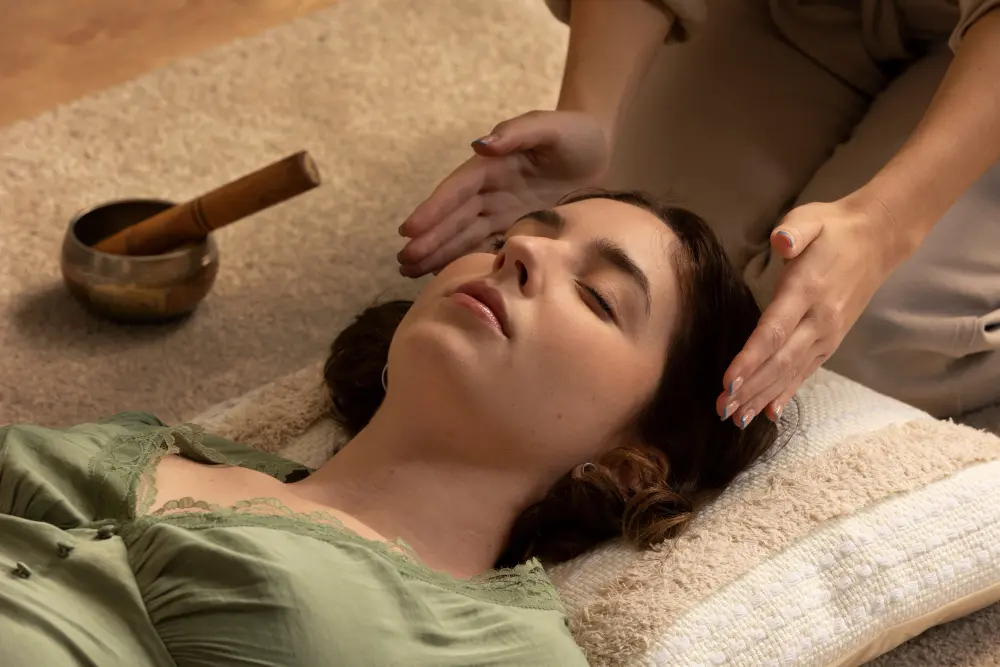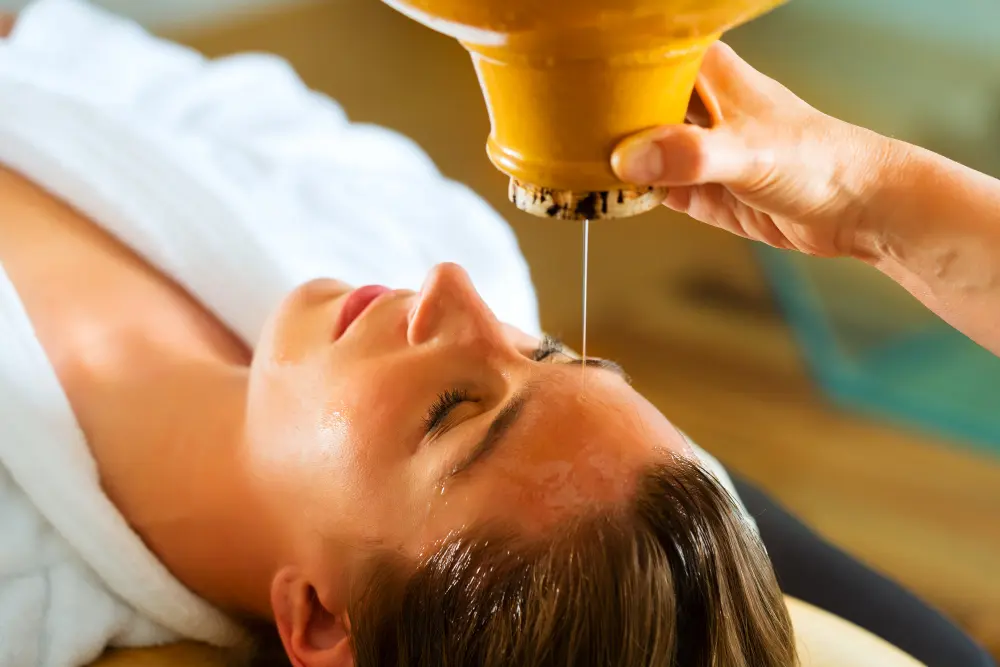In India, Ayurveda is an ancient natural healing system providing a holistic health and wellness approach. At the heart of Ayurveda lies a profound therapeutic and transformative approach known as Panchakarma, which is derived from Sanskrit, where “Pancha” means “five,” and “Karma” signifies “action” or “procedure.” Therefore, Panchakarma encapsulates 5 therapeutic procedures that detoxify, rejuvenate, and restore balance in the body, mind, and spirit.
Whether you seek relief from chronic ailments, yearn for holistic well-being, or wish to explore the depths of ancient wisdom, Panchakarma offers a path worth exploring. In this blog, let us take you on a journey into Panchakarma therapy, unveiling its principles, practices, and profound potential to heal and revitalize every aspect of your being.
About Panchakarma
Panchakarma, or Panchakarma chikitsa, is a well-known detoxification procedure in the oldest medical teachings associated with Ayurveda. Ayurvedic Panchakarma restores the body’s degenerative process and has the potential to offer long-lasting wellness. It is also the most prevalent particular therapy, using herbal treatments and medicated oils, as described in Vedic writings, to rejuvenate the mind, body, and senses and restore our inherent youth.
The original Panchakarma therapy is a blend of 5 therapies, hence the name. These therapies offer Panchakarma benefits, including removing the body’s deep-seated imbalances, detoxifying the body and mind, and creating a stress-free body.

Five Pradhana Karmas
1. Vamanam
Vamana is also known as Emesis Therapy. It is a controlled way of making someone vomit and helps with lung congestion, which leads to problems like colds, coughs, and bronchitis. This process helps eliminate extra mucus in the body, making breathing easier and reducing respiratory issues.
2. Virechanam
This therapeutic process involves expulsing toxins from the intestines achieving detoxification through purgation. This procedure of Panchakarma eliminates vitiated pitta and other morbid doshas. Virechana therapy is an integral part of Ayurvedic Panchakarma treatment, particularly beneficial for those dealing with skin issues, digestive disorders, jaundice, and acidity. This treatment utilizes natural or herbal laxatives that remove toxins from the body via the bowels.
3. Basti
Enema therapy employs herbal blends inserted into the rectum. It relieves constipation, kidney stones, and backaches while addressing piles and arthritis. This approach aids quick absorption and removes toxins from the colon through herbal decoctions infused with natural ingredients, oils, milk, and ghee.
4. Nasya
This approach addresses many concerns, including sinus and throat issues and neurological problems, and also focuses on relieving pain and addressing issues in the cerebral area. Moreover, the therapy offers hormone balance and cleansing for the forehead and temples by administering herbal drops through the nasal cavity. Nasya detoxifies the upper respiratory tract and induces deep relaxation in the cerebral region.
5. Raktamokshan
Raktamokshan is a blood-cleansing technique. It serves preventive and therapeutic purposes and can be applied to the entire body or area to counteract impure blood-related ailments, including skin infections like psoriasis and dermatitis. This purification approach prevents ulcers, herpes, tumors, and foul odors. It encompasses methods like Siravyadha (venous puncture) and Raktamokshana (leech therapy), requiring professional administration for optimal results.
These 5 steps in the Panchakarma treatment cleanse the body from within, resulting in a healthy and purified body.
Benefits of Panchakarma

Panchakarma is a traditional Ayurvedic therapeutic approach that involves cleansing and rejuvenating treatments to restore balance to the body and mind. It is often used as a holistic approach to treat various diseases and promote overall health and well-being. Panchakarma treatments are highly personalized and depend on an individual’s constitution (Prakriti), imbalances (vikriti), and specific health concerns.
Here’s how Panchakarma can help treat various diseases:
1. Detoxification
Panchakarma is primarily a detoxification process that removes accumulated toxins (ama) from the body. This improves the functioning of various organs and systems, promoting better health.
2. Balancing Doshas
Ayurveda believes that imbalances in the 3 doshas (Vata, Pitta, and Kapha) are at the root of many diseases. Panchakarma aims to balance these doshas through treatments tailored to an individual’s constitution and imbalance.
3. Improved Digestion
Many health issues stem from poor digestion. Panchakarma treatments like Abhyanga (oil massage) and Basti (medicated enema) improve digestion, nutrient absorption, and overall health.
4. Stress Reduction
Stress is a significant contributor to several diseases. Panchakarma includes relaxation techniques such as Shirodhara (pouring oil on the forehead) and meditation, which reduces stress and negatively impacts health.
5. Enhanced Immunity
Panchakarma treatments boost the natural defense mechanisms of the body by removing toxins and strengthening the immune system. This reduces the risk of infections and chronic diseases.
6. Joint and Muscle Disorders
Panchakarma can effectively treat musculoskeletal disorders like arthritis, joint pain, and muscle stiffness through therapies such as Pinda Sweda (herbal poultice massage) and Nasya (nasal administration of medicines).
7. Respiratory Issues
Conditions like asthma, allergies, and bronchitis can be managed with Panchakarma treatments like Nasya and Vamana (therapeutic vomiting), which help clear respiratory passages and reduce congestion.
8. Skin Disorders
Panchakarma therapies can purify the blood and promote healthy skin, addressing problems like psoriasis, eczema, and acne.
9. Weight Management
Panchakarma can help with weight-related issues by removing excess fat, improving metabolism, and addressing factors like poor digestion and hormonal imbalances.
10. Hormonal Imbalances
Conditions like PCOS (Polycystic Ovarian Syndrome) and hormonal imbalances can be managed through Panchakarma treatments that regulate hormones.
11. Seasonal Cleansing
Many people undergo Panchakarma at the change of seasons to maintain health and prevent seasonal imbalances. For example, a spring cleanse can help remove excess Kapha, and a fall cleanse can balance excess Pitta.
12. Preconception and Postpartum Care
Panchakarma treatment is recommended for couples planning to conceive to optimize their reproductive health. It can also be used postpartum to help the mother recover and rejuvenate.

Treatment of Diseases with Panchakarma Therapies
Panchakarma therapy offers some benefits in treating some of the conditions and issues like:
1. Digestive Disorders
Panchakarma balances the digestive system and can treat conditions like irritable bowel syndrome (IBS), indigestion, constipation, and gastritis.
2. Arthritis and Joint Pain
It reduces pain and inflammation associated with rheumatoid arthritis and osteoarthritis.
3. Stress and Anxiety
Panchakarma therapies such as Shirodhara and Abhyanga can have a calming effect on the nervous system, helping to manage stress and anxiety.
4. Skin Disorders
Ayurvedic treatments like Udwarthana and Snehana can address skin conditions like eczema and psoriasis.
5. Respiratory Disorders
Panchakarma therapies like Nasya (nasal administration of herbal oils) can be used to manage conditions like sinusitis and allergies.
6. Weight Management
Panchakarma can help with weight loss and management by addressing metabolic imbalances and promoting a healthier lifestyle.
7. Chronic Fatigue
It may help reduce fatigue and increase overall energy levels.
8. Fertility Issues
Panchakarma can be used to address reproductive health issues and improve fertility.
9. Hormonal Imbalances
It may help balance hormones in conditions like polycystic ovary syndrome (PCOS) and menopausal symptoms.
10. Emotional and Mental Well-Being
Panchakarma is for physical health and emotional and mental balance. It is beneficial to manage stress and anxiety and improve mental clarity.
Process of Panchkarma
The Panchakarma process involves 3 stages: Purvakarma, Pradhana Karma, and Paschat Karma.
a) Purvakarma
Preparing the body before the main purification procedure is essential for a better outcome of Panchakarma treatment. For this, 3 pre-purification measures are:
1. Deepana-pachana
This means oral administration of digestive herbs to boost Agni (the digestive fire) and liquefy the toxins to be easily removed from the body.
2. Snehana
Snehana means oleating the body. There are 2 types of Snehana:
- Internal Oleation
It is the administration of medicated ghee internally that is administered in increasing doses for 3-7 days. The type and dose of medicated ghee depends on the disease condition and nature of the patient.
- External Oleation
It means body massage using specific oil, which can be done for the entire body or just particular parts. Oils are selected based on the condition of the disease.
Oleation moves the toxins toward the gastrointestinal tract, softens the superficial and deep tissues, and nutirfies the nervous system.
Based on the the condition of an individual, Sahacharadi Thailam and Dhanwantharam Thailam are used for oleation.
3. Swedana
This induces sweat with the help of steam, which is done by making an individual sit in a chamber filled with herbal decoctions of steam. It removes toxins from tissues and expels them through the tiny skin and sweat pores.
b) Pradhana Karma – The Main 5 Panchakarma Therapies
Vamana helps treat Kapha dominant diseases, and the purification is done through emesis. Includes administering herbal medicines to induce vomiting and eliminate toxins through the mouth.
Virechana therapy is beneficial for pitta diseases but also valuable for kapha and vata. Inducing controlled loose motions purifies by removing toxins.
- The most popular herbal preparations for Virechana include Avipatti Powder or Avipathi Choornam. Both are meant to facilitate the procedure’s completion.
Vasti is the mother of all panchakarma processes. It purifies through the rectum and colon.
Two types of vasti are:
- Anuvasana: Enema of medicated oils
- Asthapana: Enema of decoctions
Nasya is done by putting medicated oils through the nose. The most commonly used oil for Nasya karma is Anu Thailam. It is easily instilled in the nostrils.
Raktamokshana is the removal of impure blood that is done by using a leech or puncturing the veins directly.
Specific uses of Panchakarma processes:
1. Vamana
- Chronic asthma
- Chronic cough & cold
- Chronic indigestion
- Skin diseases
- Allergies
- Diabetes
2. Virechana
- Skin disorders such as Vitiligo and Psoriasis
- Neurological diseases like Paraplegia, Hemiplegia, and paralysis
- Joint disorders
- Chronic Fever
- Diabetes
- Digestive disorders like constipation and hyperacidity
- Gynecological disorders
- Headaches
- Elephantiasis
3. Vasti
- Degenerative diseases
- Ankylosing spondylitis
- Sciatica
- Digestive diseases
- Lumbar spondylitis
- Skin diseases
- Osteoporosis
4. Nasya
- To improve eyesight
- Ear, Nose, and Throat diseases
- To improve memory
- Trigeminal neuralgia
- Hair falling
- Premature hair-greying
- Bell’s palsy
- Nasal polyps
- Breathing problems
- Headache
- Migraine
5. Raktamokshana
- Skin Diseases like acne, psoriasis, urticaria, and eczema
- Sciatica
- Elephantiasis
- Non-healing wounds
- Pain management
- Varicose veins
- Arthritis
c) Paschat Karma
This post-purification regime restores digestive power and brings normalcy to the body. It is done through a particular diet, lifestyle management, rejuvenating medicines, and specific herbal preparations. It includes:
- Sansarjan Karma: A diet protocol aims to gradually increase the intake of liquids and semi-solids to an average level.
- Administration of Rasayan: A rejuvenating medicine as per your condition that physically restores the body.
- Shaman Chikitsa: Appropriate Ayurvedic medicine may help reduce the disease symptoms.

Symptoms Indicating the Need for Panchakarma
Panchakarma is needed when the body accumulates ama (toxins), which happens with changes in lifestyle, climate, and food.
Here are a few pointers to help you realize if you need the panchakarma chikitsa:
- Tiredness and laziness throughout the day
- Unexplained body pain
- Unclear mind
- Bad breath
- Thick layer coating on the tongue
- Frequent diarrhea or vomiting
- Uncontrollable food craving
- Improper sleep-wake and food cycles
The Ayurvedic treatise mentions that panchakarma should be done once yearly so that the body and soul can sustain and nurture themselves.
Panchakarma Treatment Purifies Body and Mind

Panchakarma is a profound and holistic treatment that purifies the body and mind. Ayurveda views the proper digestion of food, experiences, and emotions as crucial for maintaining good health. The body’s intense digestive fire (Agni) effectively processes nutrients and experiences eliminating waste products and producing the subtle essence known as Ojas, which is considered the foundation of vitality, immunity, and overall well-being.
However, when Agni is weakened, it leads to incomplete digestion and the formation of toxins known as Ama. Ama accumulation disrupts the flow of energy and nutrients in the body, contributing to various health problems and diseases. The body’s inability to process thoughts and emotions can also create emotional toxins, affecting mental and emotional well-being.
Panchakarma treatment addresses these imbalances and restores the body’s innate balance and healing ability. It does so by eliminating Ama and toxins from the body, promoting the proper functioning of Agni, and rejuvenating the tissues. This improves physical health and enhances mental clarity, emotional stability, and vitality.
It’s important to remember that Panchakarma should be undertaken with caution and under the guidance of a trained Ayurvedic physician. The physician will assess your health condition, determine if Panchakarma suits you, and tailor the treatment plan to your needs. Additionally, certain conditions such as fever, injuries, and pregnancy may contraindicate Panchakarma, so consulting with a qualified practitioner is essential before undergoing the therapy.
Overall, Panchakarma is a comprehensive and time-tested approach to detoxification and rejuvenation, offering profound benefits for the body and mind.
Other Well-known Panchakarma Therapies
1. Udvartana
This involves massaging the body using herbal powders. It helps in weight loss.
2. Shirodhara
Pour warm oils directly on the forehead. This is helpful for stress and anxiety. It is also known for improving sleep patterns and boosting memory power.
3. Shiropichu
This procedure of Panchakarma involves putting herbal oil-soaked cotton over the head.
4. Shirovasti
The herbal oil is poured and kept over the head during this ayurvedic procedure.
5. Kati Vasti
Herbal oil is poured and is allowed to sit over the back region. It is an excellent process to relieve back pain.
6. Janu Vasti
The herbal oil is poured and retained over the knees.
7. Hridya Vasti
This is mainly done in the cardiac region. It strengthens the heart.
8. Njavarakizhi
It is a well-known and popular Ayurvedic massage using a tiny cloth bag filled with cooked rice and herbal powders. The bag is soaked in medicinal oil before being applied to the body. It makes you sweat. It helps with Vata issues, neurological illnesses, and joint discomfort.
9. Pizhichil
In this ayurvedic massage, a special linen cloth is dipped into heated medicinal oil and repeatedly massaged over the patient’s sick areas.
Conclusion
Stress, natural pollutants, and unhealthy lifestyles add up to a toxic load on the body that, if left in the tissues and vascular system, leads to poor health. Panchakarma’s benefits include working quickly to reverse this degenerative process and its profound and long-lasting effects. In Ayurveda, panchakarma combines massage, homegrown saunas, particular foods, moderate fasting, and colon panchakarma treatment to rid the body of impurities.
Maintaining a healthy digestive system and eliminating toxins from the body is vital for overall health. Panchakarma in Ayurveda is a natural remedy to cleanse the body and restore its inner balance and vitality, thus becoming worthy of being experimented with and having numerous panchakarma benefits.


